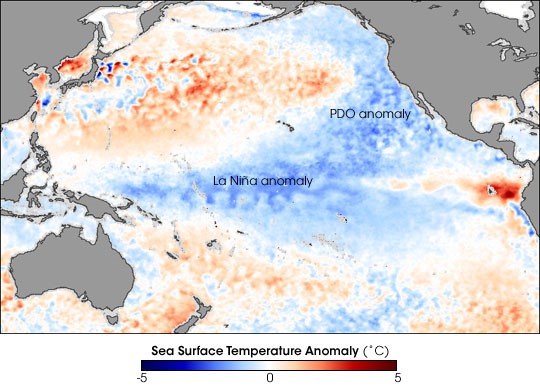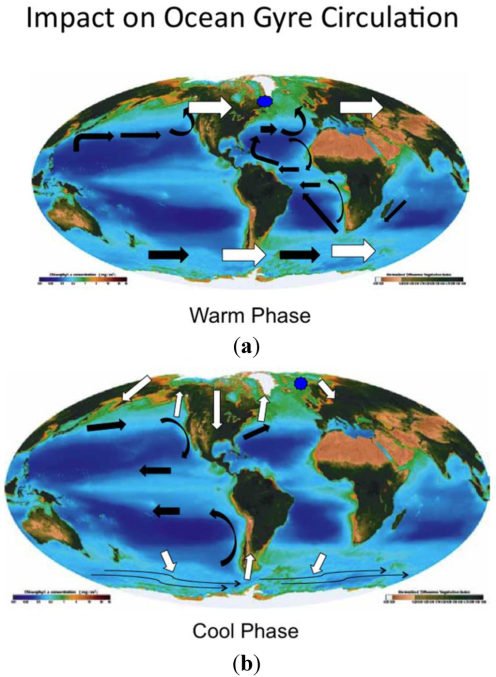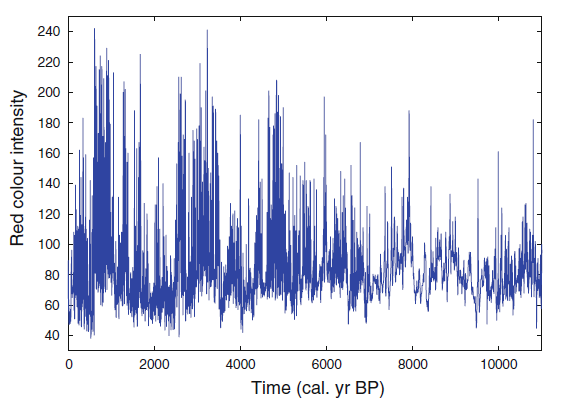It is hypothesised that upwelling in the Pacific Ocean is modulated by solar activity over periods of decades to millennia – with profound impacts on communities and ecosystems globally. The great resonant systems of the Pacific respond at variable periods – the tempo increased last century for instance – of La Niña and El Niño alternation. There are variations in this tempo at 20 to 30 years that – throwing this out there – suggest a trigger in the 22 year Hale solar cycle of magnetic reversals. The solar butterfly flutters and the cyclone ensues. Longer term indicators of solar activity show changes over millennia that mirror the state of upwelling in the Pacific. The mechanism proposed is a spinning up of the Pacific trade winds and surface gyres as a result of colder and denser polar air. Low solar activity spins up the gyres producing more frequent La Niña and a cooler northeastern Pacific (more upwelling) – and vice versa. With a cooling Sun – it suggests that the next climate shift – due in a 2018-2028 window – will be to yet cooler conditions in the Pacific Ocean. This has implications for global heat content, hydrology and biology.
The Pacific Ocean has major influences on Earth’s climate. Only glacials and interglacials – those pesky 100,000 year odd freeze cycles the world has been getting for 2.58 million years – have a greater impact. The shoaling on the Isthmus of Panama disrupted surface flow in both Pacific and Atlantic Oceans – creating the potential for feedbacks to dramatically change climate. Orbitals, bottom water formation in the northern Atlantic and runaway ice feedbacks is a more likely chain of causality at a 100,000 year cycle. But the Pacific has a globally influential role in climate variability at scales of months to millennia. The variability in atmospheric temperature, rainfall and biology has its origin in the volume of cold water rising off California and in the equatorial Pacific. It is an ever changing anomaly.
http://earthobservatory.nasa.gov/IOTD/view.php?id=8703

The principle of atmospheric heating and cooling by ENSO is very simple. Cold, nutrient rich currents cascade through the deep oceans over a millennia or more. These turbulent currents don’t generally emerge through a sun warmed surface layer. By far the most significant deep ocean upwelling is in the eastern and central Pacific. Cold water in contact with the atmosphere absorbs heat and warms as the atmosphere cools. At times there is less upwelling and warm water spreads eastward across the Pacific – warming the atmosphere. It is simple enough to see in temperature data. There are – as well – cloud feedbacks anti-correlated with sea surface temperatures that change the energy dynamic of the planet. More cloud with cooler sea surface temperatures.
http://w5ww.drroyspencer.com/latest-global-temperatures/ At

2008 was relatively cool – February 1998 and sometime last year were warm. The rapid and large changes in atmospheric temperature, rainfall and biology can best be seen in monthly data. Warm months are El Niño – cool La Niña.
Over the past century the 20 to 30 year influence of the Pacific Decadal Oscillation (PDO) anomaly can be seen in the surface records. Warming to the mid 1940’s, cooling to 1976, warming to 1998 and little change since. The PDO and ENSO are, moreover, in lockstep. A cooler PDO anomaly and more frequent and intense La Niña – and vice versa.
The atmospheric/ocean system of triggers and feedbacks varies – it varies abruptly rather than smoothly. The trigger for more Pacific upwelling is the great ocean gyres. Ocean gyres spin up on the surface through winds and planetary rotation. Positive and negative states of the Northern Annular Mode are shown below. The negative state involves relatively high pressure at the pole pushing winds, cold air and storms into lower latitudes. The negative state is associated with low solar activity. There is an equivalent system in the Southern Hemisphere.
https://www2.ucar.edu/news/backgrounders/weather-maker-patterns-map

Winds and storms pushing into lower latitudes spin up the gyres pushing cold polar water into the Californian and Peruvian currents facilitating deep ocean upwelling. Roiling cold water upwelling sets up wind, cloud and current feedback across the Pacific.
http://www.mdpi.com/2225-1154/3/4/833/htm
The figure shows global “wind and gyre circulation changes hypothesized to be associated with multidecadal (a) warm and (b) cool phases of the North and South Hemispheres. White arrows indicate regions of enhanced wind and black arrows indicate areas of enhanced gyre circulation. The blue patches indicate the sinking waters in the North Atlantic. The zonal warm phase occurred from the 1910s to 1940s and 1970s to 1990s and is characteristic of strong westerly winds in the northern and southern hemisphere. North Pacific and North Atlantic subarctic gyre circulations enhance with sinking waters associated with the northern North Atlantic winter. In the Atlantic subtropical gyre circulations also enhance. Some surface waters travel from the Indian Ocean to the south Atlantic and join the Gulf Stream in the North Atlantic. The meridional cool phase occurring from the 1940s to 1970s and 1990s to present consists of equatorward winds over the continents and poleward winds over the subarctic and sub-antarctic oceans, resulting as Rossby wave formations. Intensified circulation in subtropical gyre systems enhances upwelling and productivity in the California and Peru systems. Strengthened easterly trade winds increase equatorial current circulation in the Pacific. The background global chlorophyll is from Yoder et al.”
The mechanism involves solar UV/ozones chemistry. “A number of studies have indicated that the decreases in global mean temperature associated with a future decline in solar activity are likely to be relatively small3,4,5,6,7. However, variability in ultraviolet solar irradiance has been linked to changes in surface pressure that resemble the Arctic and North Atlantic Oscillations (AO/NAO)8,9,10 and studies of both the 11-year solar cycle11,12 and centennial timescales13 suggest the potential for larger regional effects. The mechanism for these changes is via a stratospheric pathway, a so-called ‘top-down’ mechanism, and involves altered heating of the stratosphere by solar ultraviolet irradiance.”http://www.nature.com/articles/ncomms8535
Trade winds spin up as a feedback and piles warm water against Australia and Indonesia. Sometimes the winds falter and warm water flows back eastward suppressing cold upwelling. The whole is a complex and dynamic system triggered by changes in atmospheric pressure zones at both the north and south poles. Mass movements of the atmospheric are driven by a marginal change in solar activity. A large reaction from a small jolt as expected with technically chaotic systems.
Cosmogenic isotopes provide a reliable record of relative solar activity over millennia. There are several of them and carbon 14 is convenient as it is taken up by plants and can be dated and measured. When solar magnetic currents are most active cosmic radiation is further blocked and fewer isotopes are formed from collisions of radiation with molecules in the atmosphere. Thus in the 20th century high solar activity phase – fewer isotopes were formed. A return to lower solar activity is widely expected this century.
https://en.wikipedia.org/wiki/Maunder_Minimum#/media/File:Carbon14_with_activity_labels.svg Tessa Vance and colleagues from the Antarctic Climate and Ecosystems CRC found a proxy of eastern Pacific upwelling in an ice core at the Law Dome Antarctica. A higher salt content – from polar westerlies – is a proxy for solar activity. But also results in changes in the Pacific gyres and the intensity of upwelling. More upwelling brings rain and cyclones to Indonesia and northern and eastern Australia, drought in the United States of and South America, cooler global temperatures and biological abundance. Less in El Niño conditions and we – in Australia – get drought. The absolute volume of rainfall is roughly constant but where it falls on the planet changes.
Tessa Vance and colleagues from the Antarctic Climate and Ecosystems CRC found a proxy of eastern Pacific upwelling in an ice core at the Law Dome Antarctica. A higher salt content – from polar westerlies – is a proxy for solar activity. But also results in changes in the Pacific gyres and the intensity of upwelling. More upwelling brings rain and cyclones to Indonesia and northern and eastern Australia, drought in the United States of and South America, cooler global temperatures and biological abundance. Less in El Niño conditions and we – in Australia – get drought. The absolute volume of rainfall is roughly constant but where it falls on the planet changes.
http://journals.ametsoc.org/doi/abs/10.1175/JCLI-D-12-00003.1
But even with a millennial high El Niño anomaly last century – conditions have been far more extreme at other times in the past 12,000 years.
http://www.nature.com/nature/journal/v420/n6912/abs/nature01194.html
 Christopher Moy and colleagues examined a sediment core from Laguna Pallcacocha in southern Ecuadora. More rainfall and runoff In El Niño conditions wash more red sediment into the lake. So we know it was pretty rainy in South America a 1000 years ago. Some 5,000 years ago there was a change from dominant La Niña anomalies to dominant El Niño – that dried the Sahel. Just 3,500 years ago there were a long series of El Niño with red intensity greater than 200 and civilisations fell. For comparison – red intensity in the ‘monster’ 1997/1998 El Niño event was 99.
Christopher Moy and colleagues examined a sediment core from Laguna Pallcacocha in southern Ecuadora. More rainfall and runoff In El Niño conditions wash more red sediment into the lake. So we know it was pretty rainy in South America a 1000 years ago. Some 5,000 years ago there was a change from dominant La Niña anomalies to dominant El Niño – that dried the Sahel. Just 3,500 years ago there were a long series of El Niño with red intensity greater than 200 and civilisations fell. For comparison – red intensity in the ‘monster’ 1997/1998 El Niño event was 99.
Will there be more La Niña over the next centuries? Can we expect more El Niño in a thousand years? Might we see great herds return to the Sahel? The details of the future evolution of climate remains absolutely uncertain. What is more certain is that the next global climate shift is due in a 2018-2028 window. The next shift may be to yet cooler conditions – given the 20th century high in both solar activity and El Niño intensity and frequency. Regardless of near term outcomes – it is odds on for a cooler sun and more upwelling in the Pacific Ocean this century – providing a cooling influence on the oceans and atmosphere and the inevitable regional variability in rainfall.

Hi, I desire to subscribe for this website to get
most recent updates, so where can i do it please assist.
Excellent explanation.
Dr. Akasofa described it to me as a chaotic system of cycles of cycles. Unpredictable on the short term, consistently patterned in the long term.
Very interesting. There is a huge disconnect between paleoclimatologists and solar physicists regarding the effect of solar variability on climate. Paleoclimatologists see it very clearly in climate proxies, while solar physicists reject it on the basis of a lack of mechanism. The evidence thus supports paleoclimatologists.
“Since irradiance variations are apparently minimal, changes in the Earth’s climate that seem to be associated with changes in the level of solar activity—the Maunder Minimum and the Little Ice age for example—would then seem to be due to terrestrial responses to more subtle changes in the Sun’s spectrum of radiative output. This leads naturally to a linkage with terrestrial reflectance, the second component of the net sunlight, as the carrier of the terrestrial amplification of the Sun’s varying output. Much progress has also been made in determining this difficult to measure, and not-so-well-known quantity. We review our understanding of these two closely linked, fundamental drivers of climate.’
Click to access Goode_Palle_2007_JASTP.pdf
Curiosity about an incompletely known system is dismissed as climate skepticism. They have memes rather than science.
Cheers
I would like to tell you of my latest book and documentary.
‘The Deliberate Corruption of Climate Science’.
My latest documentary and video of my presentation.
My website is
Thank you.
Tim
http://www.drtimball.com
Thanks for another insightful post on sun, ocean and climate. I reblogged with this comment:
Professional hydrologist Rob Ellison has for years been thinking and writing to connect the dots between the sun, ocean and climate. Recently he wrote this post at his excellent blog Terra et Aqua, An Earnest Discovery of Climate Causality (link in red).
Below I provide some excerpts from his discussion about an ocean mechanism which would be much better understood, were it not for the CO2 obsession sucking up most of the research funding.
Pingback: The Ocean Climate Spin Zone | Science Matters
Reblogged this on Climate Collections.